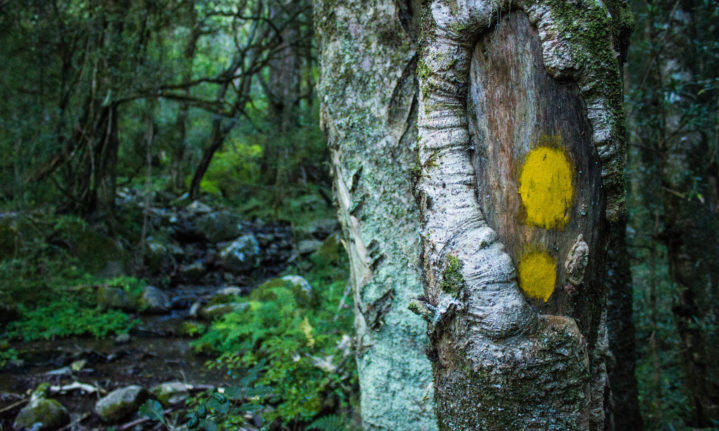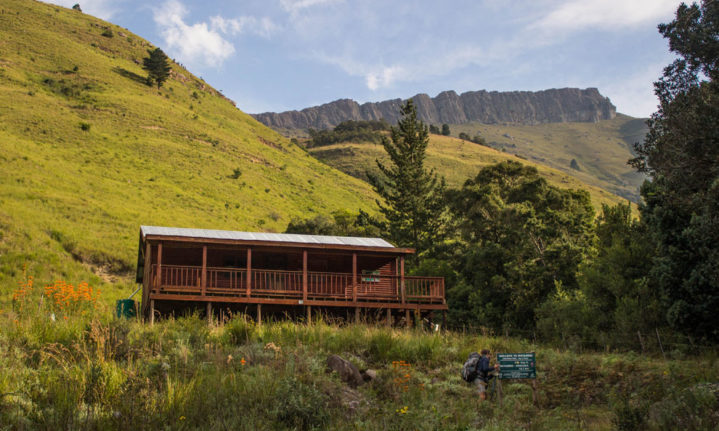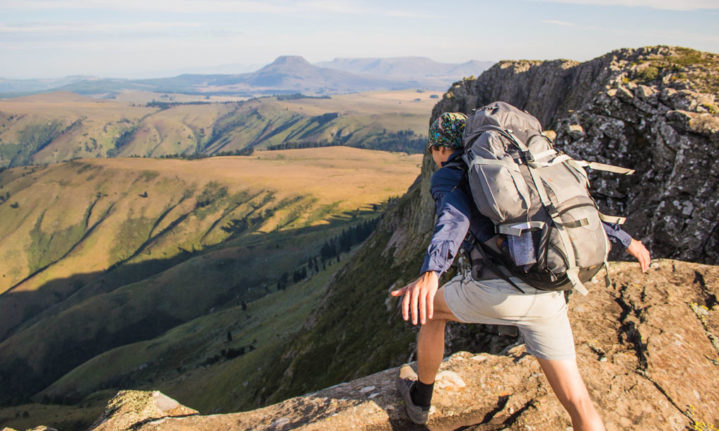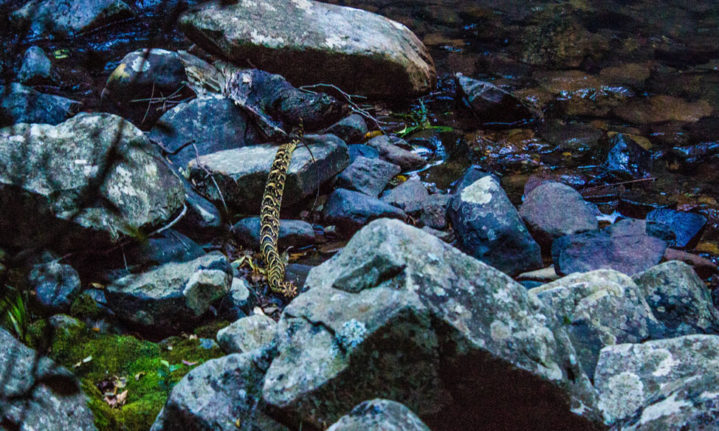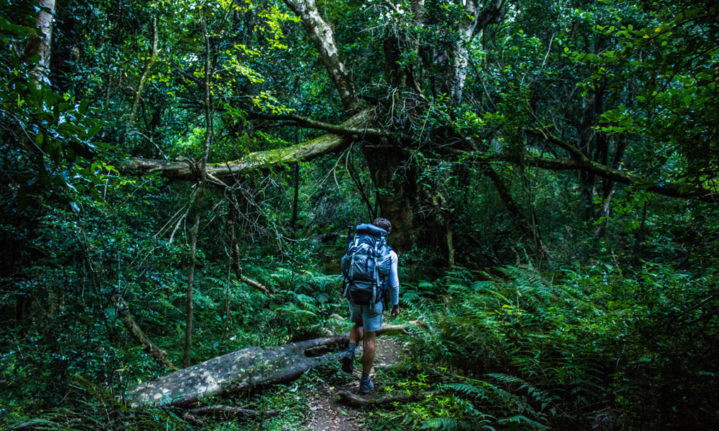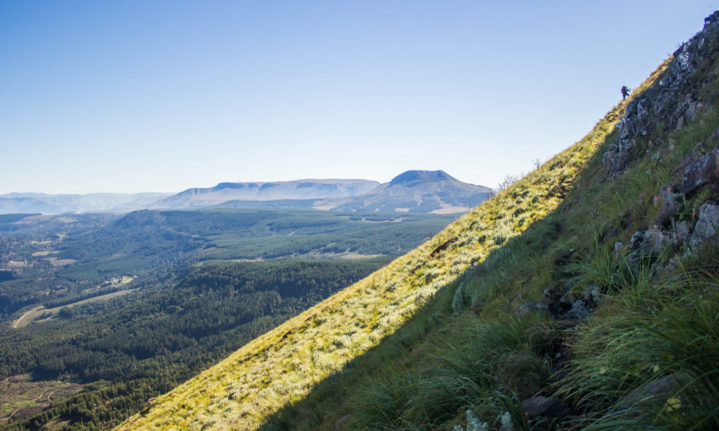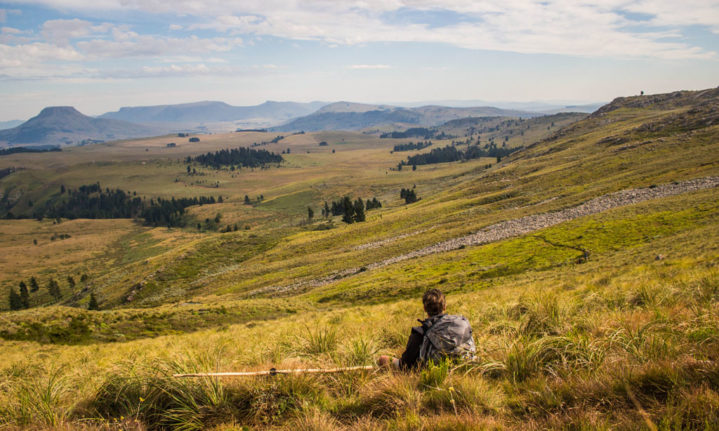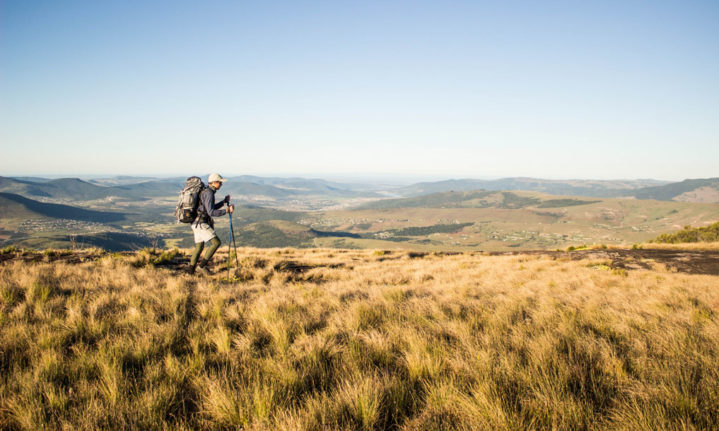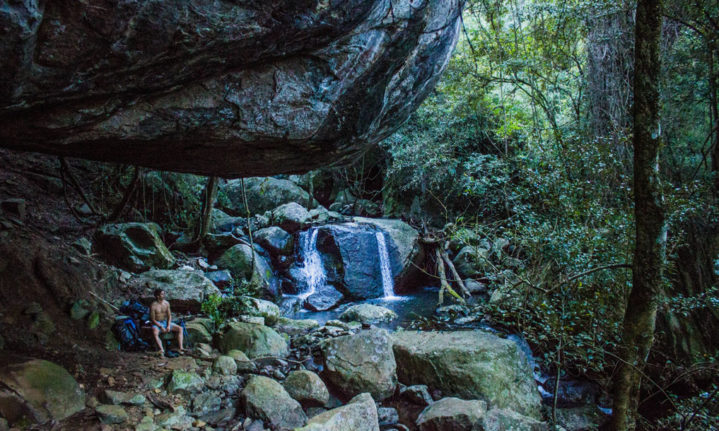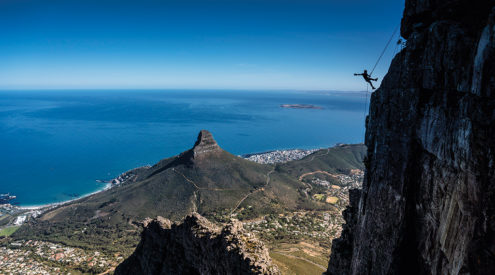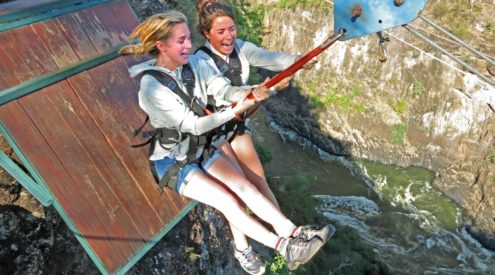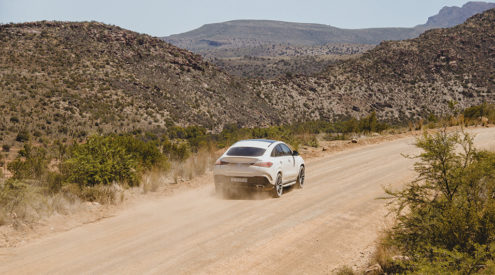This six-day, 110-km route trails through one of the last pockets of afromontane forest left in South Africa, and holds more than a few surprises.

Photo credit: Matthew Sterne
It’s sunrise on day three of the Amatola Trail and we’re already hiking. Leon and I left when it was dark, initially walking under the glow of our headlights and then allowing the soft light of a rose-pink dawn to guide us. The days are long on the Amatola Trail and we need to leave early if we’re to make it to the next hut by sunset. Besides, the forest is at its best at this time. The Cape parrots and Knysna turacos begin to stir, their squawks piercing the stillness of the forest that we walk through, like miners entering a cave. The tap-tap of our walking sticks on the wet forest floor adds its beat to the melody of a nearby river. Tiny luminescent ferns blanket the forest floor, moss covers the trees and rocks, and a canopy of leaves forms our ceiling in this verdant cavern. The trees are a mix of indigenous species such as yellowwoods, Cape chestnuts and knobwoods. Only the path is not green, but a mottled brown of forest mulch that winds through the woods like a column of smoke in a breeze.
This peaceful moment is overshadowed by the prospect of the day’s toil. Each morning promises 10 hours of descending and ascending ahead, through lush valleys and up to the flower-strewn grasslands and peaks of the Amatola Range. This is a gruelling, self-guided trail and you have to take everything with you – all your food, clothes, bedding, cookware, and accessories. Should something go wrong in this remote mountain wilderness, it’s a long way back to civilisation. But that’s the type of adventure we’re looking for. As Leon keeps telling me, ‘There has to be an element of danger for it to be a true adventure.’
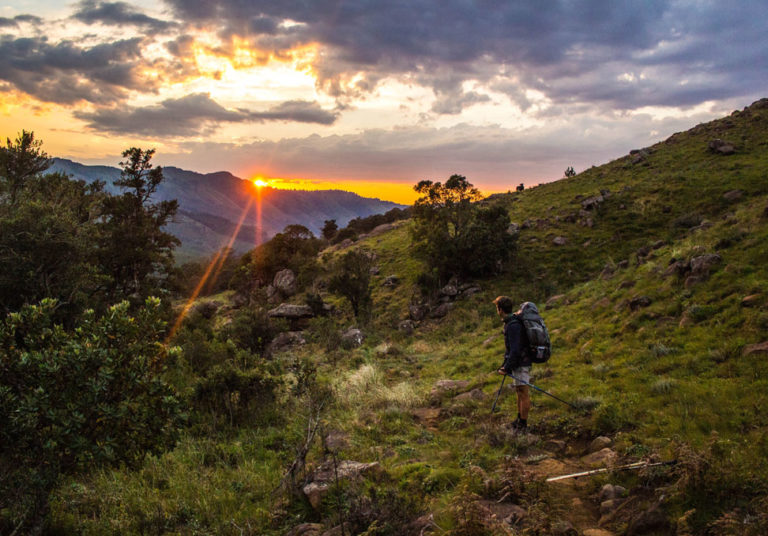
Early starts carry a reward in the Amatola Mountains. Photo credit: Matthew Sterne
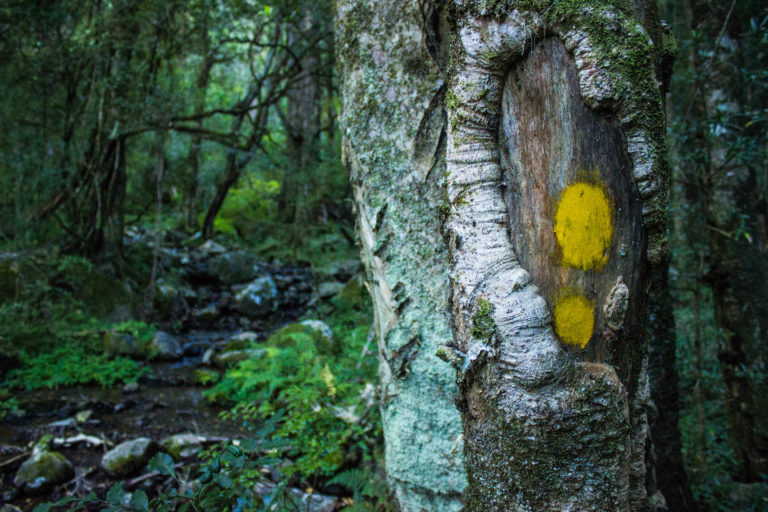
The yellow feet help you find your way (most of the time). Photo credit: Matthew Sterne
Hiking is a great ways to spend time with friends. You have all day to chat and ramble as you amble, with the ever-changing scenery acting as a catalyst for novel thoughts and meaningful conversations. Leon likes to say, ‘If you want to become best friends with someone you either go to a festival with them or on a hike.’ Our group of friends are a good example of that – we met by going to a festival together and reunited for an epic three-day hike from Cape Point to the Cape Town City Bowl. Since then, we’ve slowly explored other mountains in the Cape, in places like Kleinmond, Montagu and Boosmansbos. We normally have a group of about 12 on our hikes, but due to poor planning and a few injuries, it’s just Leon and I this time.
Leon is an incorrigible thrill-seeker, the type of guy who can’t walk past a hill without running up it, a motorbike without getting on it and a plane without wanting to jump out of it. I’m closer to the other side of the athletic spectrum. When our team was whittled down to a pair, Leon and I considered not going. But we needn’t have worried. With just two of us, it was easier to get going in the mornings, easier to cook, easier to do everything really. And it had the unintended benefit of adding stealth to our wanderings. In the mornings, we kept quiet and walked along listening to the sounds of the forest: the chatter of birds, the wind in the trees and the forest occasionally creaking under its own immense weight.

‘Just stand there and stare out and look natural, and epic, at the same time.’ The back of Leon’s head playing its part once again. Photo credit: Matthew Sterne

Leon leaning into some very strong wind and probably dreaming of jumping off the cliff in a squirrel suit. Photo credit: Matthew Sterne
Two hours into day three, we climbed up a steep, slippery path alongside a moss-covered waterfall and popped out on top with views of the surrounding landscape of hills the colour of close-clipped summer grass. Far below us we could make out tiny clusters of Xhosa huts surrounded by small kraals and uneven roads. After a snack break below Doornkop Peak, we started the long, knee-trembling descent into the enticingly-named Waterfall Forest.
Leon and I were at a small river when we met the poachers. While we were filling up our water bottles, a pack of about 40 dogs silently surrounded us. They didn’t bark or growl, just quietly joined us as if we weren’t there. It was like an eerie dream. Then the owners appeared. There were five of them and, by the looks of it, they were the bushmeat poachers we had been told about. We had a quick chat, gave them some tobacco and carried on.
The poachers and their dogs followed us and were about twenty paces back when three dogs shot off, disappearing into the bush above the trail. One of the poachers sat on his haunches in the middle of the road, communicating with the dogs in a series of guttural clicks, grunts and shouts. A yelp rang out from the thicket – a call to the other dogs – who dashed off in pursuit, a blur of predatory beige and brown. A flurry of yelps and barks echoed out of the bushes. It was a gripping scene, but we took that as our cue to leave. Ten minutes later, just as the forest seemed to be settling down, a family of five black wild pigs ran across our path. I sensed panic in their eyes. They had the look of the hunted.
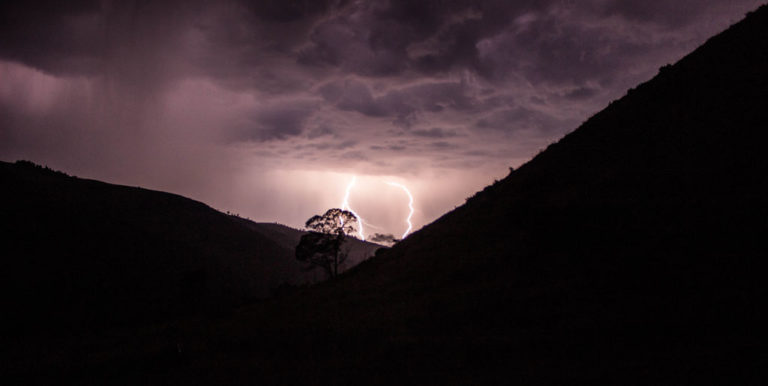
A thunderstorm raged throughout the fourth night and late into the afternoon the next day. We set off in the morning in pelting rain and marched briskly through the storm, only stopping occasionally under trees for a brief break. Photo credit: Matthew Sterne

‘Always be snacking.’ Photo credit: Matthew Sterne
Lying between King William’s Town and Hogsback, Amatola is considered one of South Africa’s toughest hikes as it covers 110km over six days. Compare that to our most famous hike, the Otter Trail, which covers just 41km over five days, and you begin to understand the nature of the challenge. Yes, there are longer hikes in the Drakensberg and Cederberg, and the Rim of Africa is something else all together, but in terms of week-long hikes, Amatola poses a unique challenge. And that, I sometimes feel, is a big part of its allure. If you can do Amatola, you can probably handle the rest.
The Waterfall Forest turned out to be a series of cascades up a forested ravine, with each one better than the last. We found small waterfalls just big enough for us to shower under, and some as tall as 30 metres. Halfway up, Leon took a step off a stone and, as his foot touched another rock, he saw the yellow head of a puff adder coil back underneath him. He instinctively jumped away before the snake could strike and, when well clear, let out a blitz of swear words.
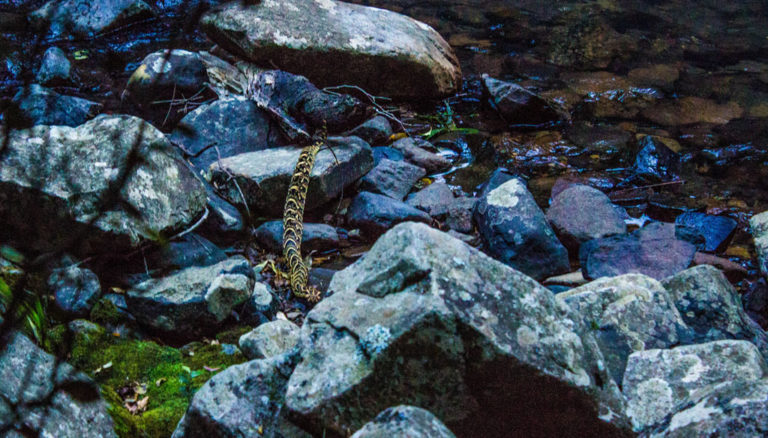
The puff adder slowly slithered towards us, it’s tongue flickering in and out for a taste of our scent, which was probably a tad musky at this stage of the hike. Photo credit: Matthew Sterne

Leon took this photo by climbing on a dead branch above the snake and, immediately after snapping it, the branch broke and he fell next to the snake. Photo credit: Leon Laubscher
We retreated and looped around to see the puff adder slithering out from under a rock. It was as thick as a man’s forearm, with a yellow-and-black pattern. A trail representative had briefed us before we started hiking. ‘There are snakes. You may encounter them,’ he said. ‘Don’t let them bite you.’ We kept that useful information in mind while we watched the puff adder stare back at us with its tongue shooting in and out of its fanged mouth. Entranced, Leon and I both struggled to look away. We eventually left it to enjoy the waterfall on its own.
We weren’t the only hikers who experienced some challenging moments on the trail. Two women in their twenties who started the hike on the same day as us had to be transported back to town, what they call ‘extracted’, on the second day because the going was too tough. The extraction cost is R1,500 and comes with a severe dent to the ego. A hiker ahead of us had it even worse. He fell and broke an ankle in three places and had to be airlifted out.
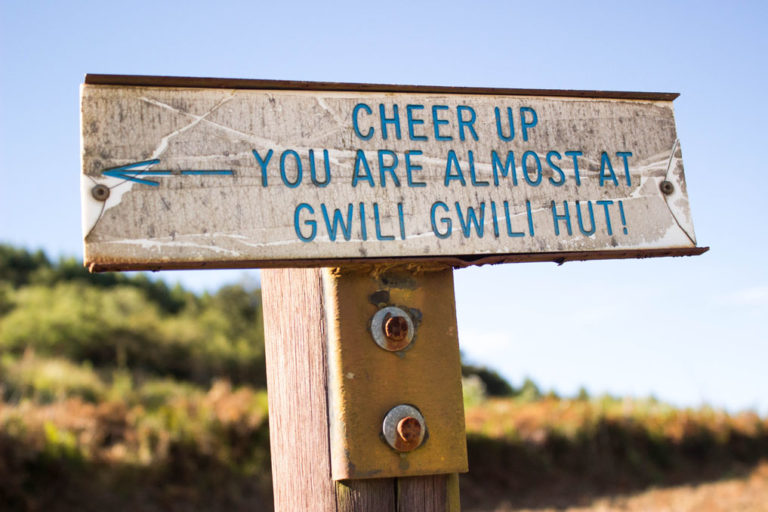
A welcome sight on day one. Photo credit: Matthew Sterne
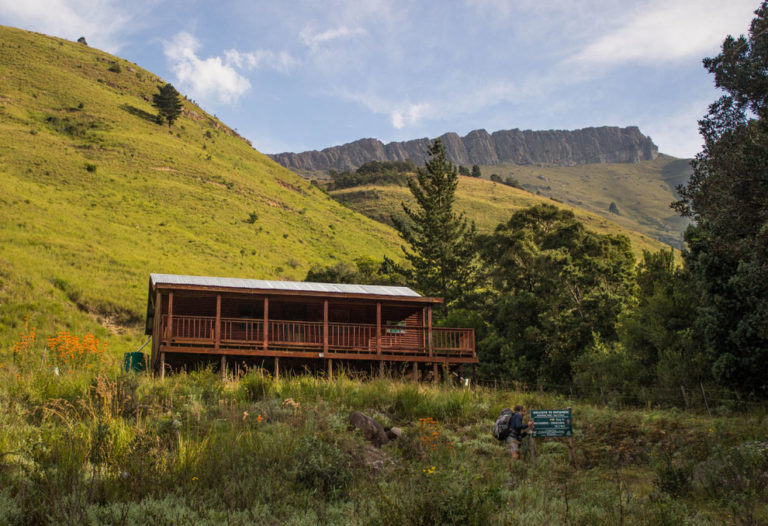
The huts have bunks with mattresses. You can see the ‘bristles’ of one of the Hogsback mountains in the background. Photo credit: Matthew Sterne
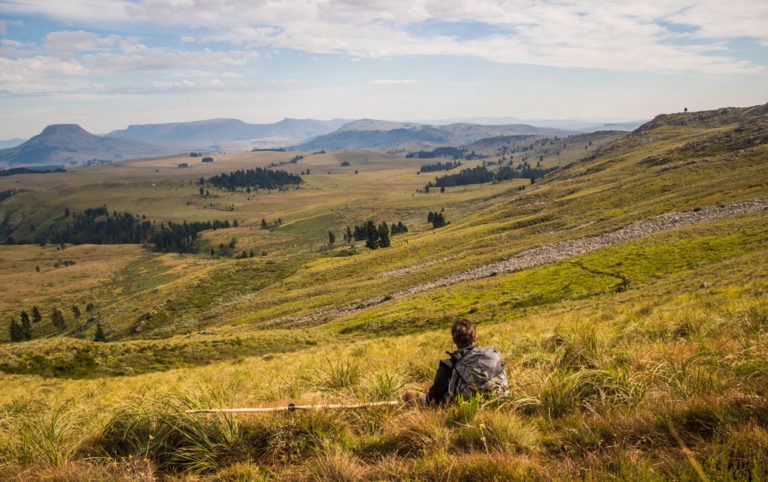
There were moments and viewpoints on the trail where we’d stop and say, ‘Ja no, this is quite nice’, and then plonk ourselves down for a snack-break. This was one of those places where we could see forever but couldn’t spot another person. Alone in that mountain wilderness with just the grass, peaks, wind, and trees – those are the memories that will pull at us and take us back there one day, I’m sure. Photo credit: Matthew Sterne
We finally exited the Waterfall Forest after 12 hours of hiking, just as the sun was setting over a ruffled landscape of beautiful hills. At the hut, we followed our nightly ritual. We had cold showers, put on warm clothes, made dinner, ate, and fell into bed. The next few days followed a similar pattern of long-but-rewarding days exploring one of the last pockets of afromontane forest in South Africa.
By the sixth and final day, Leon and I had somehow worked through all our snacks, which was not an easy feat considering the quantities of Speckled Eggs, dried fruit, nuts, and biltong we had packed. It was a proud moment. It was also encouraging that we’d managed to find our way in that unknown landscape, while laughing at our silly jokes and listening to Leon remix songs with his own weird lyrics along the way. We’d overcome a massive storm on day five, got lost (more than once), encountered snakes, done hours of boulder-hopping, and done it all with just the two of us as opposed to the large group we were used to. It had been the true adventure we’d been looking for.
As we were nearing the ridgeline of the peak that gave Hogsback its name, with the end in sight our spirits began to rise with every step. We finally crested the hill and were welcomed with a view of the picturesque town of Hogsback, our final destination, below us. A feeling of euphoria bubbled up inside us. Leon got so excited, he ran up a hill just for fun. It may be a cliché, but it’s true: a hike like this reminds you that with patience and persistence, anything is possible. Even one of South Africa’s toughest hikes.
Plan your trip
Visit amatolatrails.co.za for more information.










